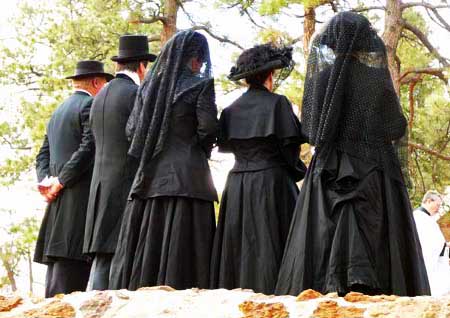
In the midst of my mourning, I have been pondering how grief was experienced in North America a couple centuries ago. It was very different.
A death in the family entailed long periods of mourning traditions, and was accompanied by many grief rituals. The period of mourning was often more than a year long, and a person dressed in black or dull materials to symbolize the absence of life. Grieving women also often wore special bonnets, caps or veils. Furthermore, the dresses had large cuffs, referred to as “weepers,” that were used to wipe the nose during fits of crying. Even homes were fully draped in black crepe banners to signify that there had been a death.
Our country began to move away from these traditions during the Civil War because there were so many deaths, almost the entire South was in mourning. (Many Northern soldiers died as well.) The general morale of people was greatly affected by the sight of so many dressed in black. It was depressing. So America’s mourning traditions began to change out of necessity.
Though some of these traditions seem a bit extreme, I think our recent civilization has lost something in removing them altogether. We live in a culture that does not know how to grieve; ours is a society that is not very receptive to mourning and sadness. Though never stated outright, one is expected to move on, and there is little space given for the brokenness experienced in the death of a loved one. In fact, I don’t think we even know what to do with the realities of death. It is an uncomfortable subject, often avoided by the masses.
Considering my current pain and grief, a year of mourning, the general rule of thumb centuries ago, seems rather brief. My mom heard a gentleman on the radio describing how the grief over losing his son was a period of about ten years. Though it has only been a month and a half since Jud died, I have already felt pressure from society-at-large, to re-engage life in normalcy.
Strangely, it feels as though it would actually be more fitting for me to be dressed in black with a grief veil-it would indicate to people that my life is not normal now. I have a big gaping hole in my heart. I am experiencing the absence of Jud’s life with every single breath. It would also eliminate some of the awkwardness of telling others that my son just died…they would know, simply by my attire that sensitivity may be appropriate. Not to mention, those large cuff “weepers” could be quite handy for all the episodes of sobbing that overtake me at unexpected times.
Moreover, though this is such a sad statement about our lack of true community in this society, I think only two neighbors in our townhome complex know that we just lost our son. When we see other neighbors, we smile and wave, but my heart sinks as I ponder the fact that they have no idea our son just died. In these moments, I can’t help but think that draping our home with a black banner to signify our loss, wouldn’t be such a bad idea.
Of course, I embrace these antiquated grief rituals in jest, but something must be said of the benefits; they allowed a grieving person to acknowledge their loss publicly, which offered more sensitivity, more time for mourning, and death was not such a taboo subject.
Our society today can take some valuable lessons from these obsolete grieving practices.